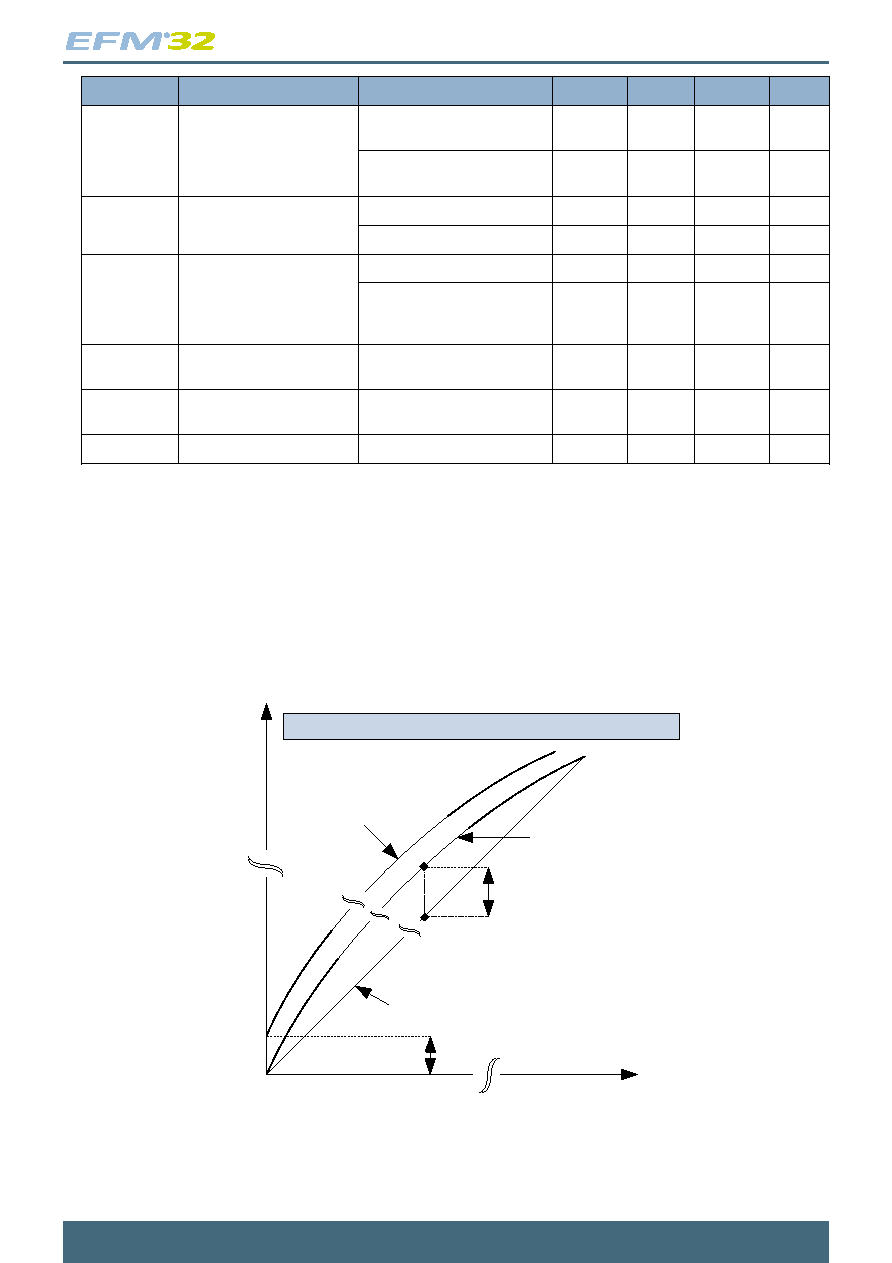- 您现在的位置:买卖IC网 > Sheet目录1918 > EFM32G230F128 (Energy Micro)IC MCU 32BIT 128KB FLASH 64QFN

...the world's most energy friendly microcontrollers
2013-06-28 - EFM32G230FXX - d0005_Rev1.60
36
www.energymicro.com
Symbol
Parameter
Condition
Min
Typ
Max
Unit
200 kSamples/s, 12 bit, differ-
ential, VDD reference
79
dBc
200 kSamples/s, 12 bit, differ-
ential, 2xVDD reference
79
dBc
After calibration, single ended
0.3
mV
VADCOFFSET
Offset voltage
After calibration, differential
0.3
mV
-1.92
mV/°C
TGRADADCTH
Thermometer output gradi-
ent
-6.3
ADC
Codes/
°C
DNLADC
Differential non-linearity
(DNL)
±0.7
LSB
INLADC
Integral non-linearity (INL),
End point method
±1.2
LSB
MCADC
No missing codes
11.999
1
12
bits
1On the average every ADC will have one missing code, most likely to appear around 2048 +/- n*512 where n can be a value in
the set {-3, -2, -1, 1, 2, 3}. There will be no missing code around 2048, and in spite of the missing code the ADC will be monotonic
at all times so that a response to a slowly increasing input will always be a slowly increasing output. Around the one code that is
missing, the neighbour codes will look wider in the DNL plot. The spectra will show spurs on the level of -78dBc for a full scale
input for chips that have the missing code issue.
The integral non-linearity (INL) and differential non-linearity parameters are explained in Figure 3.25 (p.
36) and Figure 3.26 (p. 37) , respectively.
Figure 3.25. Integral Non-Linearity (INL)
Ideal t ransfer
curve
Digit al ouput code
Analog Input
INL= |[ (VD-VSS)/VLSBIDEAL] - D| where 0 < D < 2
N - 1
0
1
2
3
4092
4093
4094
4095
VOFFSET
Act ual ADC
t ranfer funct ion
before offset and
gain correct ion
Act ual ADC
t ranfer funct ion
aft er offset and
gain correct ion
INL Error
(End Point INL)
发布紧急采购,3分钟左右您将得到回复。
相关PDF资料
EFM32G232F64
IC MCU 32BIT 64KB FLASH LQFP64
EFM32G280F64
MCU 32BIT 64KB FLASH 100-LQFP
EFM32G290F64
MCU 32BIT 64KB FLASH 112-BGA
EFM32G840F64
MCU 32BIT 64KB FLASH 64-QFN
EFM32G842F64
IC MCU 32BIT 64KB FLASH LQFP64
EFM32G880F128
IC MCU 32BIT 128KB FLASH 100QFP
EFM32G890F64
MCU 32BIT 64KB FLASH 112-BGA
EFM32GG230F512
IC MCU 32BIT 512KB FLASH 64QFN
相关代理商/技术参数
EFM32G230F128G-E-QFN64R
功能描述:128K FLASH, 16K RAM, AES 制造商:silicon labs 系列:Gecko 包装:剪切带(CT) 零件状态:在售 核心处理器:ARM? Cortex?-M3 核心尺寸:32-位 速度:32MHz 连接性:I2C,IrDA,智能卡,SPI,UART/USART 外设:欠压检测/复位,DMA,POR,PWM,WDT I/O 数:56 程序存储容量:128KB(128K x 8) 程序存储器类型:闪存 EEPROM 容量:- RAM 容量:16K x 8 电压 - 电源(Vcc/Vdd):1.98 V ~ 3.8 V 数据转换器:A/D 8x12b,D/A 2x12b 振荡器类型:内部 工作温度:-40°C ~ 85°C(TA) 封装/外壳:64-VFQFN 裸露焊盘 供应商器件封装:64-QFN(9x9) 标准包装:1
EFM32G230F128-QFN64
制造商:Energy Micro AS 功能描述:MCU, 128K FLASH, USART+UART 3, QFN64 - Tape and Reel 制造商:Energy Micro AS 功能描述:MCU, 128K FLASH, USART+UART 3, QFN64 - Cut TR (SOS) 制造商:Energy Micro 功能描述:energy micro EFM32G230F128-QFN64 Microcontrollers (MCU) 制造商:Energy Micro AS 功能描述:IC MCU 32BIT 128KB FLASH 64QFN
EFM32G230F128-QFN64T
制造商:Energy Micro AS 功能描述:MCU, 128K FLASH, USART+UART 3, QFN64 - Trays
EFM32G230F128-QFN64-T
制造商:Energy Micro AS 功能描述:IC MCU 32BIT 128KB FLASH 64QFN
EFM32-G230F128-SK
功能描述:IC MICRO KIT GECKO 64QFN RoHS:是 类别:套件 >> 半导体产品 - IC 元件分类 系列:Gecko 其它有关文件:NXPLOGIC2-KIT-ND Contents 标准包装:1 系列:74AUP 套件类型:逻辑 值:180 件 - 18 种值各 10 件 包装:- 安装类型:表面贴装 包括封装:6-XSON,8-XSON,8-XQFN 产品目录页面:2653 (CN2011-ZH PDF) 工具箱内容:(10) 568-4391-1-ND - IC GATE MULT-FUNC CONFIG 6-XSON(10) 568-4390-1-ND - IC CONFIG MULT-FUNC GATE 6-XSON(10) 568-4389-1-ND - IC GATE DUAL FUNCTION 8-XSON(10) 568-4388-1-ND - IC GATE DUAL FUNCTION 8-XQFN(10) 568-4387-1-ND - IC F-F D-TYPE POS EDGE 8-XSON(10) 568-4386-1-ND - IC F-F D-TYPE POS EDGE 8-XQFN(10) 568-4385-1-ND - IC CONFIG MULTI-FUNC GATE 6-XSON(10) 568-4384-1-ND - IC EX-OR GATE 3-IN 6-XSON(10) 568-4383-1-ND - IC F-F D-TYPE POS EDGE 6-XSON(10) 568-4382-1-ND - IC LATCH D-TYPE 6-XSON更多... 其它名称:NXPLOGIC2-KIT
EFM32G230F128-T
制造商:Energy Micro AS 功能描述:IC MCU 32BIT 128KB FLASH 64QFN
EFM32G230F32
功能描述:ARM微控制器 - MCU 32KB FLASH 8KB RAM 32MHZ 1.8-3.8V
RoHS:否 制造商:STMicroelectronics 核心:ARM Cortex M4F 处理器系列:STM32F373xx 数据总线宽度:32 bit 最大时钟频率:72 MHz 程序存储器大小:256 KB 数据 RAM 大小:32 KB 片上 ADC:Yes 工作电源电压:1.65 V to 3.6 V, 2 V to 3.6 V, 2.2 V to 3.6 V 工作温度范围:- 40 C to + 85 C 封装 / 箱体:LQFP-48 安装风格:SMD/SMT
EFM32G230F32-QFN64
制造商:Energy Micro AS 功能描述:MCU, 32K FLASH, USART+UART 3, QFN64 - Tape and Reel 制造商:Energy Micro AS 功能描述:IC MCU 32BIT 32KB FLASH 64QFN